








Jaipur and Dehli – a window on Indian art
Without wishing to cast too much shade on the rigours of February, last month I skipped our shores to make a long-planned trip to India. What started in my mind as a voyage of architectural discovery, evolved into a highly rewarding deep dive into an ancient and contemporary art world, bearing fruit across studio visits, exhibitions, galleries and private homes.
Over two weeks of encounters with artists, gallerists and curators, I enjoyed a relaxed accessibility and openness to engage, particularly in Jaipur where I joined The Cultivist, a global art members’ club. Spending time with artists in their own studios is something I really enjoy, it’s such a privilege and enables a deeper experience of the work. I was also invited to see several collections in private residences, which was inspiring in relation to our own work at Richard Parr Associates, bringing insights to my thinking on multi-generational living and integrating art and interior design.
Nothing quite prepared me for the level of skill, detail and patience in the art I saw, from historical works to the exploding creativity of the contemporary Indian art scene. What struck me is the impact of context, not only historic and political but also in terms of materials and traditional crafts such as miniature painting and jewellery making.
Starting in the past; a visit to the third-generation miniature artist, Riyaz Uddin. His studio sits within a multi-generational household where paints are ground from pigments mixed in shells and exquisite paintings created with single-hair brushes, a tradition dating back to the Mughal Empire.
In contrast, Tanya Goel’s contemporary vision is highly geometric and abstract, though her technique is also inspired by the work of Indian miniaturists, as she too extracts colours from natural sources and uses traditional pigments. Today many colour extraction methods are illegal, so Goel is finding safe and sustainable ways to make pigments. Having seen her work at Frieze in London last year, it was exciting to visit her studio and find out more about her use of colour and the concepts of botanical existence that she condenses into her practice.
Beyond the intimacy of studio visits, I was also able to explore a range of work at independent galleries and the Indian Art Fair in New Delhi. There I found the heritage of India at play again underpinning techniques, infusing colour and craft to create highly collectable works, made by artists often less well known in Europe.
The impact of Mughal landscapes threading through to contemporary work is something I find fascinating. In the paintings of Madhurjya Dey, the focus on moody and evocative suburban landscapes narrating themes of melancholy and loneliness are extremely powerful, despite, or perhaps because of their tiny size. I find them to be deeply moving and was lucky to bring his work back to the Cotswolds.
Exploring the latest work of Rashmi Mala, you can unpack the influences of botanical illustration, plant collectors, natural history and ecology. Her works combine drawing, painting and a blended techniques including cyanotype (sometimes known as ‘sun printing’) to mirror historic botanical art in a modern idiom that resonates with her academic research and memories of the past.
These are just a snapshot of the many memorable artist encounters I had whilst in India. It is always hard to make an edit like this so I’m expanding on it in a further post, but what brings these artists together is the foundation of techniques and approach that leads them each down such different pathways. I find it completely beguiling.
